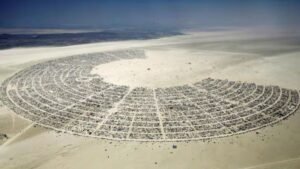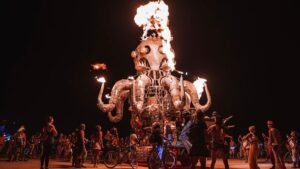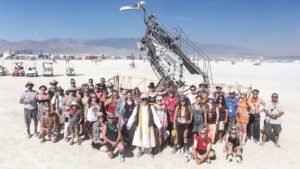Burning Man: An Exploration of Art, Community, and Radical Self-Expression
Introduction
Burning Man is not merely a festival; it’s an annual gathering that transforms the barren Nevada desert into a vibrant city of art, culture, and community. Each year, tens of thousands of participants converge in Black Rock City to experience a unique blend of creativity, self-expression, and collaborative living.
The event culminates in the symbolic burning of a massive wooden effigy known as The Man representing both the fleeting nature of art and the spirit of the community. This article delves into the history, culture, principles, artistic endeavors, challenges, and transformative impact of Burning Man.(toogoodonline)

Historical Context
The origins of Burning Man can be traced back to 1986 when Larry Harvey and a group of friends constructed an 8-foot wooden figure and set it ablaze on Baker Beach in San Francisco.
This spontaneous act was intended as a celebration of summer and a symbol of liberation. The following year, the group decided to relocate the event to the Black Rock Desert in Nevada, where the first official Burning Man took place in 1990.
Initially, the gathering was small, attracting around 90 participants. However, as word spread, the event grew rapidly, evolving from a simple bonfire into a complex and multifaceted festival. By the mid-1990s, attendance had surged into the thousands, and the festival began to adopt the principles that would define it in the years to come.
The Principles of Burning Man
At the core of Burning Man are ten guiding principles that shape the culture and ethos of the event:
1).Radical Inclusion There are no prerequisites for participation, and all individuals are welcomed regardless of their background or beliefs.
2).Gifting: The culture of gifting is foundational to the festival. Participants are encouraged to give freely to others without expecting anything in return, fostering a sense of community and generosity.
3).Decommodification: The festival actively resists commercialism. Attendees are discouraged from engaging in typical consumer practices, which allows for an environment where creativity and self-expression can flourish without commercial influences.
4).Radical Self-reliance: Participants are encouraged to be self-sufficient, bringing everything they need for the duration of the event. This principle promotes resilience and fosters a sense of responsibility for one’s own experience.
5).Radical Self-expression: Attendees are invited to express their individuality and creativity in any form they choose. This can manifest through art, performance, costumes, and other forms of personal expression.
6).Communal Effort: Burning Man is built on collaboration and teamwork. Participants work together to create the infrastructure of Black Rock City, including art installations, theme camps, and communal spaces.
7).Civic Responsibility: The festival emphasizes the importance of acting responsibly and positively engaging with both the community and the environment. Participants are encouraged to leave the space better than they found it.
8).Leaving No Trace: Sustainability is a key value at Burning Man. The principle of leaving no trace requires participants to clean up after themselves and minimize their ecological impact.
9).Participation: The event thrives on active involvement. Spectators are discouraged, and everyone is invited to contribute in some way, whether through art, volunteering, or sharing their skills.
10).Immediacy: Burning Man encourages participants to live in the moment and fully engage with their experiences. This principle promotes mindfulness and an appreciation for the present.

Art and Creative Expression
Art is an integral part of the Burning Man experience, with the desert becoming a canvas for large-scale installations and interactive art pieces. Artists from around the world are invited to create immersive works that challenge traditional notions of art and engage participants in new ways.
The installations often reflect themes of transformation, connection, and the human experience. Many pieces are designed to be temporary, reinforcing the idea that art is ephemeral and should be appreciated in the moment. This transient nature fosters a unique atmosphere where art is not only observed but also experienced and interacted with.
Art at Burning Man is diverse, ranging from stunning sculptures to intricate light displays and performance art. Attendees are encouraged to explore the various installations, interact with the artists, and even participate in the creation of art themselves.
This emphasis on participatory art allows for a deeper connection between the creator and the observer, blurring the lines between artist and audience.
Community Building and Connection
One of the most transformative aspects of Burning Man is its capacity to foster a strong sense of community. Many attendees describe the festival as a life-changing experience, where they form deep connections and friendships that can last long after the event concludes. The absence of commercial distractions creates an environment where genuine interactions can flourish.
Theme camps play a significant role in building community. These self-organized groups create communal spaces that offer a variety of activities, from yoga classes to workshops on art and creativity.
Theme camps encourage collaboration and participation, allowing attendees to share their skills and talents with others.
The spirit of radical inclusion ensures that everyone can find a place within the community. Whether through shared meals, collaborative art projects, or social gatherings, participants engage with one another in meaningful ways, creating a sense of belonging that transcends the boundaries of everyday life.

Challenges and Criticisms
As Burning Man has grown in popularity, it has faced a variety of challenges and criticisms. The increasing commercialization of the event, rising ticket prices, and environmental impact have sparked discussions about the future of the festival and its original ethos.
Many long-time participants express concern that the festival’s spirit is being compromised by the influx of wealthy attendees and corporate sponsors.
Critics argue that the core principles of radical self-reliance and decommodification are threatened by the commercialization of the experience.
In response to these challenges, the Burning Man organization has implemented measures to address issues of sustainability and accessibility.
Initiatives like the Leave No Trace philosophy aim to minimize the ecological footprint of the festival, while discussions around inclusivity work to ensure that Burning Man remains a welcoming space for all.(toogoodonline)
The Burning Ritual: Symbolism and Significance
The climax of the festival is the burning of The Man. This ritual serves as a powerful symbol of transformation, representing the release of the past and the celebration of new beginnings.
As the effigy is engulfed in flames, participants gather to reflect on their experiences and engage in a collective celebration of creativity and community.
The burning ritual is rich in symbolism. It embodies the cyclical nature of life and art, reminding attendees that both are fleeting and ever-changing.
The act of watching The Man burn encourages introspection and contemplation, prompting participants to consider their personal journeys and the connections they’ve made throughout the week.
Moreover, the ritual serves as a unifying experience, bringing participants together in a shared moment of awe and celebration.
As the flames rise into the night sky, attendees often feel a profound sense of belonging and connection to the larger community.
Environmental Sustainability and Responsibility
With its rapid growth, Burning Man has faced scrutiny over its environmental impact. The festival takes place in a fragile desert ecosystem, and the influx of thousands of participants can put significant strain on the environment. In response, the organizers have emphasized sustainability and environmental responsibility.
The Leave No Trace principle is a cornerstone of this commitment. Participants are required to remove all of their waste and belongings, ensuring that the desert is left as it was found. Additionally, the festival encourages the use of sustainable practices, such as solar power and recycling, to minimize ecological harm.
The Burning Man organization has also partnered with environmental groups to promote awareness and education about desert conservation. Workshops and discussions on sustainability are held during the event, encouraging participants to think critically about their impact on the environment.
The Global Impact of Burning Man
Burning Man’s influence extends far beyond the desert. The festival has inspired a global movement, leading to the creation of numerous regional events that embody its principles and spirit. These gatherings, often referred to as Burns take place in various countries and serve as local expressions of the core values of Burning Man.
Regional Burns allow participants to engage with the principles of radical inclusion, gifting, and self-expression in their own communities. They provide a space for creativity and connection while fostering a sense of belonging among participants.
Furthermore, the ideas and values propagated by Burning Man have permeated various aspects of contemporary culture. The emphasis on creativity, collaboration, and self-exploration resonates in art, technology, and social movements, encouraging individuals to seek alternative ways of living and engaging with one another.

Personal Transformations and Stories
Many attendees of Burning Man describe the festival as a transformative experience that reshapes their perspectives on life and community. Personal stories of growth, healing, and connection abound, highlighting the profound impact the event can have on individuals.
For some, Burning Man serves as a catalyst for self-discovery. Participants often arrive at the festival with preconceived notions of who they are, only to leave with a deeper understanding of themselves and their place in the world. The freedom to express oneself authentically fosters an environment where individuals can explore their identities without judgment.
The festival also provides a space for healing and reflection. Many attendees have shared stories of overcoming personal challenges, whether related to mental health, grief, or societal pressures. The supportive community and immersive experiences at Burning Man create an environment conducive to personal growth and healing.(toogoodonline)
Conclusion: The Enduring Spirit of Burning Man
Burning Man is a unique convergence of art, community, and radical self-expression that challenges conventional societal norms. While the festival continues to evolve, its core principles ensure that it remains a space for creativity, connection, and personal transformation.
As participants return to their everyday lives, many carry the lessons of Burning Man with them, embracing the values of radical inclusion, self-expression, and community. The event leaves an indelible mark on all who attend, inspiring individuals to
In a world that often prioritizes consumerism and superficial interactions, Burning Man stands as a powerful reminder of the importance of community, creativity, and the celebration of the human spirit. As the flames of “The Man” flicker and fade into the night, the legacy of Burning Man continues to burn brightly in the hearts of those who experience its magic.
FAQs
Q1. What is Burning Man?
Ans: Burning Man is an annual festival held in the Black Rock Desert of Nevada, focused on art, self-expression, and community.
Q2. When does Burning Man take place?
Ans: The festival typically occurs in late August to early September, culminating on Labor Day weekend.
Q3. How do I get tickets?
Ans: Tickets can be purchased through the official Burning Man website during a ticket sales period, which usually occurs in the spring.
Q4. What should I bring to Burning Man?
Ans: Participants should bring everything they need for the week, including food, water, shelter, and personal items. Costumes and art supplies are also encouraged!
Q5. Is Burning Man family-friendly?
Ans: Yes, Burning Man is open to all ages, and there are family-friendly activities and spaces available.
Q6. What are theme camps?
Ans: Theme camps are self-organized groups that create communal spaces for various activities, performances, and social gatherings.
Q7. What is the significance of The Man?
Ans: The Man is a large wooden effigy burned at the festival’s climax, symbolizing creativity, transformation, and the ephemeral nature of art.
Q8. How is sustainability addressed at Burning Man?
Ans: The festival emphasizes the “Leave No Trace” principle, requiring participants to clean up after themselves and minimize environmental impact.
Q9. Can I sell items at Burning Man?
Ans: Selling goods or services is discouraged. Instead, participants are encouraged to engage in gifting and sharing.
Q10. What is the overall vibe of Burning Man?
Ans: The atmosphere is one of radical self-expression, creativity, and community, fostering connections and encouraging participants to explore their individuality..
Thanks for reading
Enjoyed this article? Spread the word! We’re eager to hear your suggestions for future mobile topics in the comments!
